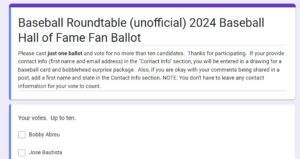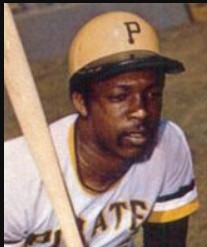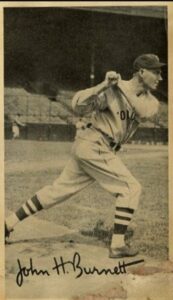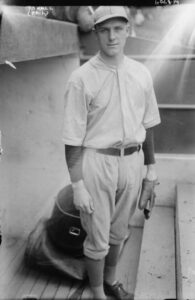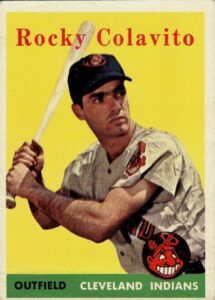The 2024 Baseball Writers Association of America (BBWAA) Baseball Hall of Fame ballots are out – and that means the 2024 Hall of Fame Debate Season is officially underway! Eligible BBWAA members have until December 31 to cast their ballots (they can vote for up to ten candidates), with results announced January 23, 2024 and the 2024 Induction Ceremony slated for July 21. This year’s traditional ballot includes 14 holdovers from last year, along with 12 newcomers. This also means the Baseball Roundtable (unofficial) Baseball Hall of Fame Fan Ballot is once again open for voting. This unofficial balloting will officially close at midnight January 2.
In this post, BBRT will share:
- The Roundtable’s predictions for the official BBWAA balloting; BBRT’s ballot (if I had one);
- A deep look at all the candidates on the ballot; and
- A link to BBRT’s unofficial fan ballot – please take a few minutes to follow the link and cast your votes – you could become eligible for a baseball card and bobblehead surprise package.
—PARTICIPATE IN BASEBALL ROUNDTABLE’S 2023 FANS’ HALL OF FAME BALLOT—
Baseball Roundtable is once again conducting an unofficial fan ballot – to cast your vote(s), click here. Remember, you can vote for up to ten of the nominees for 2024 induction. If you want to read through the nominees’ bios first, there is another link to the BBRT Fan Ballot following the bios (near the end of this post). BBRT will be providing updates on the fan balloting, as well as a post-election comparison of fan votes as compared to the final BBWAA results.
Also, if you leave your email address in the Contact Info section at the end of the ballot, you will be entered in a bobblehead and baseball card “surprise-prize” drawing. You will find a link to the ballot after the biographies.
To skip the post and go directly to the fan ballot, click here.
As you consider this year’s slate of candidates, BBRT would stress that all the players on the ballot – even those who remain for only one voting cycle – deserve recognition. To rise to the major leagues, last ten years and make it past the Hall of Fame Screening Committee is a significant accomplishment in itself. In fact, the annual ballot release is a highlight for Baseball Roundtable, as it provides a chance to acknowledge the accomplishments of all the candidates – not just the favorites for election. For example, a review of this year’s ballot gives us the opportunity to honor Mark Buehrle’s perfect game; the 30-30 seasons of Brandon Phillips and David Wright; Bobby Abreu’s 30-40 season; Jose Bautista’s nickname and 54-homer season; Jose Reyes’ batting title; Matt Holliday’s season-opening 45-game streak of reaching base safely; and more.
Now on to the official 2023 Baseball Hall of Fame election process itself – and, then, a look at the players on the ballot for 2023.
BASEBALL HALL OF FAME ELIGIBILITY/CRITERIA FOR ELECTION
The basic rules for eligibility are that a player must have played at least ten seasons and be retired for at least five years. In addition, the player must be approved for the ballot by the Hall of Fame Screening Committee.
A player can remain on the ballot for up to ten years, but must receive at least five percent of the vote in the preceding year’s ballot to remain on the ballot. Each voter can vote for up to ten candidates. Election requires that a player be named on at least 75 percent of the ballots cast.
The criteria for election: “Voting shall be based upon the player’s record, playing ability, integrity, sportsmanship, character, and contributions to the team(s) on which the player played.”
A few preliminary comments form Baseball Roundtable.
This year’s ballot has a strong cadre (12) of first-time candidates, led by Adrian Beltre, Joe Mauer and Chase Utley. I expect at least one of those (perhaps two) to be elected and about half of the twelve first-timers to garner enough support to remain on the ballot. In contrast, in 2023, when there were 14 first-timers on the ballot, none were elected and 12 dropped off the ballot.
Voters have shown a willingness to vote in first timers. In the last ten elections 14 first-timers have been granted a ticket into the Hall: 2022 – David Ortiz; 2020 – Derek Jeter; 2019 – Mariano Rivera & Roy Halladay; 2018 – Chipper Jones & Jim Thome; 2017 – Ivan Rodriguez; 2016 – Ken Griffey, Jr.; 2015 – Randy Johnson, Pedro Martinez & John Smoltz; 2014 – Greg Maddux, Tom Glavine,& Frank Thomas.
The 2023 ballot also includes just one player in his final year of eligibility – Gary Sheffield. In the past three elections, Sheffield has moved from 40.6% to 55.0%. Twenty points seems an unlikely jump.
The holdovers with the most support year ago are Todd Helton (72.2%), Billy Wagner (68.1%) and Andruw Jones (58.1%). The Hall seems withing striking distance for Helton and Wagner and I expect them to make the trip.
Baseball Roundtable Predictions for the BBWAA Balloting: This year I expect Todd Helton and Billy Wagner to get the call, along with first-time nominee Adrian Beltre. I also have a good feeling about Joe Mauer’s chances to join Beltre as a first-time electee. (More thoughts on individual candidates in the bios.)
Again, to jump directly to the ballot itself, click here.
— PLAYERS WHO WOULD GET BBRT’S VOTE –
Adrian Beltre – 3B, 1998-2018 (Dodgers, Mariners, Red Sox, Rangers) … First Year on the Ballot

Photo: Cacophony, CC BY-SA 3.0 <http://creativecommons.org/licenses/by-sa/3.0/>, via Wikimedia Commons
Adrian Beltre offers a combination that always impresses The Roundtable – lumber and leather. He not only swatted 477 home runs over his career, but also earned five Gold Gloves and four Silver Slugger Awards (precious metal in The Roundtable’s view).
Beltre, signed by the Dodgers (out of the Dominican Republic) as a 15-year-old in 1994 (the Dodgers were punished by MLB for signing Beltre before his 16th birthday), was in the majors by the age of 19 – and he was still an active major-leaguer (119 games) in 2018 (his age-39 season).
Beltre was a three-time All Star. He led his league in home runs once (with 48 for the Dodgers in 2004) – and had nine seasons of 25 or more homers, as well as five seasons of 100+ RBI and seven seasons with an average of .300 or better. He also led the league in hits and doubles once each.
Cycling’s Yellow Hersey.
Adrian Beltre is one of just six players to hit for the cycle (single, double, triple, home run in one game) three times in his career. He accomplished the feat with the Mariners in 2008 and the Rangers in 2012 and 2015. Others on this short list include: John Reilly, Bob Meusel, Babe Herman, Christian Yelich and Trea Turner.
Beltre is among MLB’s top-50 all time in: base hits (3,166 – 18th); doubles (636 – 11th); home runs (477 – 31st); extra-base hits (1,151 – 15th); total bases (5,309 – 15th); and RBI (1,707 – 25th). In the field, Beltran is second all-time in putouts at third base (2,194 and five seasons leading the league); third in assists at third base (5,182, once leading the league); and second in double plays at third base (523, once leading the league).
Adrian Beltre’s Best Season: In 2004, Beltre went .334-48-121 for the Dodgers – leading the league in home runs. That season he also collected a career-high 200 hits, scored a career-high 104 runs; and delivered a career-best 376 total bases.
_______________________________________
Todd Helton – First Base, 1997-2013 (Rockies) … Sixth year on the ballot, 72.2 percent last year.
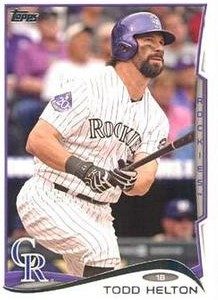 Todd Helton moved from 16.5% of the vote to 72.2% percent between his first and fifth years on the ballot. It looks like this should be the year for Helton. Helton was hampered a bit in hie early years on the ballot by the fact that he spent his entire 17-year career with the Rockies (playing half his games in hitter-friendly Coors field). Helton, who put up a .316 career average, hit .345 at home and .287 on the road. Despite that split, Helton’s body of work clearly deserves Hall of Fame consideration.
Todd Helton moved from 16.5% of the vote to 72.2% percent between his first and fifth years on the ballot. It looks like this should be the year for Helton. Helton was hampered a bit in hie early years on the ballot by the fact that he spent his entire 17-year career with the Rockies (playing half his games in hitter-friendly Coors field). Helton, who put up a .316 career average, hit .345 at home and .287 on the road. Despite that split, Helton’s body of work clearly deserves Hall of Fame consideration.
Helton was a five-time All Star, three-time Gold Glover and four-time Silver Slugger. He hit over .300 in 12 seasons – and won the NL batting crown in 2000 with a .372 average. His 59 doubles that season are tied for the seventh-most all-time. Helton drove in 100 or more runs in five seasons and scored in triple figures six times. His 1,335 walks (38th all-time) indicate the respect he earned at the plate. Helton also ranks fifth in games played at first base, third in career assists at the position, 13th in putouts and third in double plays.
400 Rocks
Todd Helton is one of only 18 players to reach 400 or more total bases in a season – and one of only seven players to have multiple 400+ total base campaigns. He is also one of only 12 players with 100 or more extra-base hits in a season; one of only three with multiple seasons with at least 100 extra-base hits and the only player with consecutive seasons of 100 or more extra-base hits (2000-2001).
Todd Helton’s Best Season: In 2000, Helton won the NL batting crown with a .372 average – and also led the league in base hits (216), doubles (59), RBI (147), on-base percentage (.463), slugging percentage (.698) and total bases (405). He also scored 138 runs and hit 42 home runs.
He gets BBRT’s vote (as he has in the past). I expect this is his year to pass 75 percent.
__________________________________
Billy Wagner – LHP, 1995-2010 (Astros, Phillies, Mets, Red Sox, Braves) … Ninth year on the ballot, 68.1 percent last year.
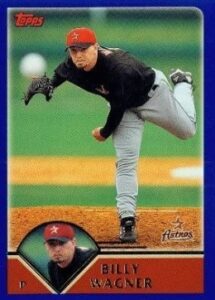 Billy Wagner was a seven-time All Star, who amassed 422 saves (sixth all-time) in a 16-season MLB career. He had nine seasons of 30 or more saves; a career ERA of 2.31; 1,196 career strikeouts in 903 innings; and 47-40 won-lost record.
Billy Wagner was a seven-time All Star, who amassed 422 saves (sixth all-time) in a 16-season MLB career. He had nine seasons of 30 or more saves; a career ERA of 2.31; 1,196 career strikeouts in 903 innings; and 47-40 won-lost record.
_____
Whiff-and-Poof
In 1992, playing for Ferrum College, Billy Wagner set an NCAA record for strikeouts per nine innings in a season at 19.3.
_____
Billy Wagner’s Best Season: In 2003, Wagner went 1-4, 1.78 for the Astros, saving 44 games and fanning 105 batters (and walking just 23) in 86 innings.
BBRT thinks Wagner belongs in the Hall (based on his 400+ saves) – and hopes that momentum continues to build. Wagner has been gaining more support lately – in the last five ballots his percentages have gone 16.7, 31.7, 46.4 and 51.0, 68.1. He should gain more ground in this year’s ballot, and has a good chance to make the 75 percent mark. He gets my vote.
________________________________
Joe Mauer – C/1B, 2004-2016 (Twins) … First Year on the Ballot.

Photo: Keith Allison from Hanover, MD, USA, CC BY-SA 2.0 <https://creativecommons.org/licenses/by-sa/2.0>, via Wikimedia Commons
Maybe I’m being a homer (living in the Twin Cities), but I believe Mauer has earned a first-ballot selection. Consider that among players playing primarily catcher, Maurer is:
- The first and still only AL catcher to win a batting title;
- One of just seven major-league catchers to win a batting title (Negro Leagues records form 1920-48 are now considered major league);
- One of just two catchers to win three batting titles (the other is Josh Gibson, who won three Negro National League II batting titles).
Mauer was a six-time All star and the 2009 American league MVP – and has three Gold Gloves and five Sliver Slugger Awards on his Hall of Fame resume
Mauer was primarily a catcher from 2004 until 2013, when a concussion led to a move to first base. During those ten seasons behind the plate, he hit .323-105-634. Mauer’s final MLB stat line was .306-143-932, with 1,018 runs scored and 2,123 hits.
For The Roundtable, those ten pre-concussion seasons – with three batting titles, an MVP Award, six All Star selections, five Silver Sluggers and three Gold Gloves is enough to put Mauer in the Hall. He gets my vote.
Joe Mauer’s Best Season: In 2009, Joe Mauer hit .365, with 28 home runs, 96 RBI and 94 runs scored. He led MLB in average and on-base percentage (.444) and led the AL in Slugging percentage. He was the AL MVP, getting 27 of 28 first place votes.
-________________________________________
Carlos Beltran – Outfield, 1998-2017 (Royals, Astros, Mets, Giants, Cardinals, Yankees, Rangers) … Second year on the ballot, 46.5 percent last year.

Photo: djprybyl on Flickr (Original Versions) UCinternational (Crop), CC by 2.0 <https://creativecommons.org/licenses/by/2.0>, via WikimediaCommons
Carlos Beltran played in 20 MLB seasons He had his best years with the Mets, making the All-Star team in five of seven seasons. (Beltran was a nine-time All Star.)
____________________
Let’s Get This Party Started
Beltran was the American League Rookie of the Year in 1999, when he hit .293-22-108 for the Royals, with 27 steals and 112 runs scored.
___________________
In his 20 MLB campaigns, Beltran hit .279-435-1,587, with 312 stolen bases and 1,582 runs scored. He ranks in MLB’s top 50 in home runs (47th), RBI (41st) and total bases (34th). His 2,725 hits are 62nd all-time and his 1,582 runs scored 53rd.
Not Exactly Playing It Safe, But It Works
Among players with at least 200 stolen base attempts, Carlos Beltran’s 86.4 percent success rate is fourth all-time.
Beltran drove in 100 or more runs in eight seasons, scored 100 or more runs in seven seasons, hit 30+ home runs in four campaigns (a high of 41 in 2006), stole 25 or more bases five times (a high of 42 in 2004). He was also a three-time Gold Glover. Beltran was also a solid post-season performer, hitting .307-16-42 in 65 post-season games. In 2004, with the Astros, he hit .435, with 20 hits, eight home runs, 14 RBI, 21 runs scored and six steals in 12 post-season games (NL Division Series & NL Championship Series). You read that right, 21 runs scored in 12 games.
Carlos Beltran’s Best Season: In 2006, Beltran hit .275, with 41 home runs, 116 RBI, 127 runs scored and 18 stolen bases and also won a Gold Glove. He finished fourth in the NL MVP voting.
Beltran would get Baseball Roundtable’s vote and I expect him to finish in the neighborhood of 57-60 percent in this year voting. His .279 career average and the fact that he never led the league in any of the major offensive categories may cost him a few votes. Longer-term, I’d say h Hl is in nis future. Right now, he gets my vote.
_______________________________
Andruw Jones – CF, 1996-2012 (Braves, Dodgers, Rangers, White Sox, Yankees) … Seventh Year on the Ballot, 58.1 percent last year.

Carl Fredrickson (Digi360) from Roswell, GA, USA, CC BY 2.0 <https://creativecommons.org/licenses/by/2.0>, via Wikimedia Commons
In a 17-season career – primarily patrolling centerfield – Jones won ten Gold Gloves (consecutively, 1998-2007). He was a defensive icon in the garden. At the plate, he hit .254, with 434 home runs (48th all-time), 1,289 RBI and 1,204 runs scored. He topped 25 home runs in ten seasons (six over thirty and a league-leading and career-high 51 in 2005). He scored 100 or more runs four times, drove in 100+ five times and stole twenty or more bases in a season four times. Jones appeared in 76 post-season games, hitting .273, with ten home runs and 34 RBI.
On the Big Stage
In the 1996 World Series, Andruw Jones – just 19-years-old – hit .400 (8-for-20) with two home runs and six RBI, becoming the youngest player to go yard in the Fall Classic.
Andrew Jones’ Best Season: In 2005, Jones hit only .263, but led the NL in home runs (51) and RBI (128) and won a Gold Glove for his play in CF. He finished second in the MVP voting to Albert Pujols (.330-41-117).
Jones’ ten Gold Gloves work in his favor, but – over the long haul – that .254 average (he only hit .300 or better once and over .270 only four times) dampen his HOF chances. Still that power and his defense get him Baseball Roundtable’s vote. And, he is showing momentum. His vote total in recent balloting: 2020 – 19.4%; 2021 – 33.9%;2022 – 41.4%; 2023 – 58.1%. This may not be his year, but he still has time. I expect him to move up a few percentage points in this year’s balloting.
_________________________________
Francisco Rodriguez – RHP, 2002-17 (Angels, Mets, Brewers, Orioles, Tigers) – Second year on the Ballot., 10.8 percent last year.
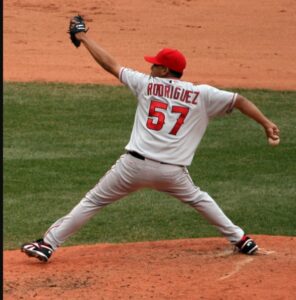
Photo: Toasterb at the English language Wikipedia project, CC BY-SA 3.0 <http://creativecommons.org/licenses/by-sa/3.0/>, via Wikimedia Commons
Francisco Rodriguez played in 16 MLB seasons, going 52-53, 2.86 with 437 saves (fourth all-time) in 948 mound appearances (21st all-time).
Rodriguez was a six-time All Star. He led the AL in saves three times and saved 40 or more games in six seasons and 20 or more in 11. In the five seasons from 2005 through 2009, he averaged 46 saves per season.
Rodriguez had an earned run average under 2.00 in two seasons and under 2.50 in seven campaigns. A true closer, Rodriguez pitched 976 innings in his 948 appearances, fanning 1,142 batters (10.5 per nine innings).
One of A Kind
Francisco Rodriguez, who saved 62 games for the 2008 Angels, is the only pitcher in MLB history with 60 or more saves in a season.
In his 2002 debut MLB season, the 20-year-old Rodriguez pitched in 11 post-season games for the Angels – recording five wins (one loss) – giving up four earned runs in 18 2/3 innings, while fanning 28. What makes this especially noteworthy is that Rodriguez made his MLB debut on September 18 of that season and went 0-0, with no saves in five games (5 2/3 innings). So, he had five post-season victories before he recorded his first regular-season decision of any kind.
Francisco Rodriguez’ Best Season: In 2008 (Angels), Rodriguez saved an all-time record 62 games – in 69 opportunities. He put up two wins (three losses) and a 2.24 ERA in 76 appearances – and fanned 77 batters in 68 1/3 innings.
BBWAA voters have traditionally been very demanding of relievers (although the recent inductions of Mariano Rivera and Trevor Hoffman are a good sign – but they, of course, both had 600+ saves). It also helps that Lee Smith (478 saves) was elected by the Today’s Game Committee in 2019. Still given how long it’s taken Billy Wagner to move past the 65 percent mark, I don’t expect Rodriguez to make it this year. I would expect him to move closer to the 20-25 percent4 line. He would get my vote.
_______________
Torii Hunter -(OF, 1997-2015 (Twins, Angels, Tigers) … Fourth Year on the Ballot, 6.9 percent last year.

Photo: Keith Allison, CC BY-SA 2.0 <htt[ps://creativecommons.org/licenses/by-sa/2.0>. via Wikimedia Commons
For his career, Hunter hit .277 (2,452 hits), with 353 home runs, 1,391 RBI, 1,296 runs scored and 195 stolen bases. He hit 20+ home runs in 11 seasons, drove in 100+ runs twice and stole 20+ bases in three campaigns. Hunter hit .274-4-20 in 48 post-season games.
Hunter led his league in CF assists three times, CF putouts once and double plays turned out of CF four times. He also led his league’s right fielders in putouts, assists and double plays once each.
Spider-Man
Torii Hunter earned the nicknamed spiderman for his outstanding outfield play.
Torii Hunter’s Best Season: In 2007 (Twins), Hunter hit .287, with 28 home runs, 107 RBI, 94 runs scored and 18 steals – although he can look back on at least four seasons with very similar numbers.
Nine Gold Gloves, five All Star selections and 353 home runs represent some pretty good credentials. Hunter’s chances to make the Hall would have been better with a couple of standout/spectacular/memorable seasons mixed in with all those consistently very, very good campaigns that fans came to expect. He also earns extra credit for leadership and character, as he was known as a leader in the club house and an asset in the community. He may slip off the ballot this year, but he gets my vote.
___________________________________________
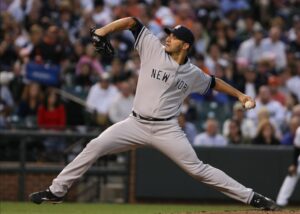
Photo: Keith Allison on Flickr. Cropped by User: Staxringold., CC BY-SA 2.0 <https://creativecommons.org/licenses/by-sa/2.0>, via Wikimedia Commons
Andy Pettitte – LHP, 1995-2010, 2012-13 (Yankees, Astros) … Sixth year on the ballot, 17.0 percent last year.
As I’ve noted in past years, I had to think for a while on this one (and will probably get some push back from readers), largely because a major part of Andy Pettitte’s HOF resume was achieved in the post-season and there was some PED-controversy surrounding Pettitte. (Note: Pettitte admitted to using HGH while recovering from elbow surgery – a couple of years before the substance was banned. He took responsibility and apologized.)
Pettitte holds the MLB post-season marks for most wins (19 … versus 11 losses), innings pitched (276 2/3), games started (44) and is fourth in strikeouts (183). His post-season accomplishments include a 3.81 career ERA and the 2001 American League Championship Series MVP Award.
Pettitte also was no slouch in the regular season. He finished with 256 wins (153 losses) and a 3.85 ERA. His 256 wins currently rank 43rd all-time and his 521 starts 41st. Pettitte won 20 games in two seasons and 14 or more games 12 times – leading the AL with 21 wins in 1996. The three-time All Star struck out 2,448 batters (46th all-time) in 2,316 innings.
Ready, Willing and Able …
Andy Pettitte started 30 or more games in a season 12 times, leading his league three times (1997, 2006, 2007).
Andy Pettitte’s Best Season: In 1997, following a 21-8 campaign in 1996, Pettitte went 18-7, with a 2.88 ERA (fourth-best in the AL), leading the league in starts with 35, finishing third in innings pitched (240 1/3) and eighth in strikeouts (166).
Pettitte’s post-season numbers, plus 256 regular-season victories and the fact that he had 100+ more career wins than losses secure BBRT’s vote. He has a long way to go with the BBWAA voters. The Roundtable thinks he deserves better and see Pettitte as significantly underrated by BBWAA voters.
_________________
Bartolo Colon – RHP 1997-2009, 2011-2018) … Indians, Expos, White Sox, Angels, Red Sox, Yankees, A’s, Mets, Braves, Twins, Rangers.
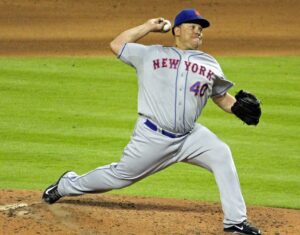
Photo: Jeffrey Hayes, CC BY 2.0 <https://creativecommons.org/licenses/by/2.0>, via Wikimedia Commons
Okay, Bartolo Colon was not originally on my “vote for” list, but looking a little deeper, I changed my mind. How can you not like a guy, who pitches until he’s 45-yers-old, is listed in baseball-refence.com as 5’11’ and 285 pounds, takes the mound for eleven different MLB teams, practically explodes with his love for the game, wins 247 games and carried the nickname “Big Sexy.”
Bartolo Colon pitched in 21 MLB seasons, going 247-188, 4.12 in 565 appearances, (552 starts). He was a three-time All Star, won the 2005 AL Cy Young Award, won 15 or more games in eight seasons, fanned 2,535 batters in 4.461 2/3 innings. He ranks 51st all-time in wins, 36th in strikeouts,
Ten-Four, Good Buddy
In 2002, Bartolo Colon started the season with the Indians and ran up a 10-4, 2.55 record before being traded to the Expos on June 27 – where he ran up a 10-4, 3.31 – giving him an evenly split 20-8 campaign.
Bartolo Colon’s Best Season. In 2005, with the Angels, Colon was the AL Cy Young Award winner with a 21-8, 3.48 campaign
Just Put Up A Target, I’ll Do The Rest
On April 18, 2012, Bartolo Colon threw 38 consecutive strikes (pitching for the A’s against the Angels). The streak lasted from the second pitch of the fifth inning to the seventh pitch of the eighth inning. A few stats: 35 of the pitches were fastballs; there was only one swing and miss; there were 17 called strikes; there were ten foul balls; ten balls were put in play. For the game, Colon went eight scoreless innings (four hits, no walks, five whiffs) in a 6-0 win. He threw 108 pitches, 82 strikes.
Colon clearly had an exciting career, and 247 wins cannot be ignored. Ultimately, his 4.12 ERA may dampen HOF changes. This vote came from the heart. It will be fund to see him on the ballot again in the coming year., although not as much fun as seeing him pitch.
Tired of reading? To cast your vote, click here.
THE REST OF THE SLATE
So, with BBRT’s unofficial ballot covered, let’s look at the remainder of candidates – in alphabetical order. Note: Here you will find a host of players with solid (but perhaps not HOF-level) career numbers and accomplishments – as well as a few that remain on the sidelines for other reasons.
Bobby Abreu – OF, 1996-2012, 2014 (Astros, Phillies, Yankees, Angels, Dodgers, Meets) … Fifth Year on the Ballot, 15.4 percent one year ago.
A solid .291 career hitter (2,470 base hits), Abreu hit .300 or better in six seasons. He hit 20 or more round trippers in 10 campaigns, stole 20 or more bases 12 times (a high of 40 in 2004), drove in 100 or more runs eight times and scored at least 100 runs eight times. Abreu also walked 1,476 times – including 100 or more free passes in eight straight seasons (1999-2006).
In the Top 50 …
Bobby Abreu’s 1,476 walks are 20th all-time; his 574 doubles are 25th; his 3,733 putouts as a RF are 12th; and his 130 assists as a RF 28th.
In 20 post-season games, Abreu went 19-for-67 (.284), with one home run and nine RBI.
Bobby Abreu’s Best Season: In 2004, as a Phillie, Abreu hit .301, with 30 home runs and 40 steals. An All Star that season, he also drove in 105 runs and scored 118.
Abreu’s 400 steals are an HOF plus, as are his 30-40 season in 2004 and his eight campaigns with 100 or more RBI. Had he reached 300 home runs; it would have really boosted his status with the writers. He’s also hurt by the fact that he only made two All Star teams in his 18 seasons.
_____________
Jose Bautista – OF/3B, 2004-2018 (Orioles, Rays, Pirates, Blue Jays, Braves, Mets, Phillies) … First Year on the Ballot.
In his 15 MLB seasons, Bautista was an All Star six times (consecutively 2010-15). Overall, he hit .247, with 344 home runs, 975 RBI and 1,022 runs scored in 1,798 games. He earned the nickname Joey Bats in Toronto, where he had his best seasons. From 2008 through 2017 (with the Blue Jays), he hit .253-288-766 and twice lead the AL in home runs (54 in 2010 and 43 in 2011).
Jose Bautista’s Best Season: In 2011, Bautista hit .302-43-103 – also scoring 105 runs and leading the MLB with 132 walks. (This, by the way, followed up a .260-54-124 season in 2010.)
A solid career, should be good enough to keep him on the ballot for 2025, but short of Hall of Fame expectations.
_______________________________________
Mark Buehrle – LHP, 2000-15 (White Sox, Marlins, Blue Jays … Fourth year on the ballot, 10.8 percent one year ago.
Mark Buehrle pitched in 15 MLB campaigns and threw 200 or more innings in all but his rookie and final seasons. Buehrle was a five-time All Star and put up a 214-160, 3.81 record, with 1,870 strikeouts in 3,283 1/3 innings. He twice led his league in starts and twice topped his league in innings pitched. He won ten or more games in 15 consecutive seasons and six times won 15 or more. Buehrle also earned four Gold Glove Awards.
Near-Perfect and Perfect
Mark Buehrle’s HOF resume is bolstered by a no-hitter tossed on April 18, 2007 – when his White Sox topped the Rangers 7-0 and Buehrle faced the minimum 27 batters. The only Texas’ base runner came on a fifth inning, one-out walk to Sammy Sosa, whom Buehrle then picked off first base. Buehrle notched eight strikeouts in the game, which was so-o-o very close to a “perfecto.”
Buehrle got his perfect game two years later (July 23, m 2009), when he recorded a clean slate in a 5-0 ChiSox win over the Rays. He fanned six in that one.
Mark Buehrle’s Best Season: In 2005, Buehrle went 16-8, 3.12 for the White Sox.
If he had 250 wins to go with the no-hitter, perfect game and four Gold Gloves, Buehrle would have had my vote. With 214 wins, no Cy Young Award and no 20-win season, Buehrle appears short of what voters are looking for.
____________________________
Adrian Gonzalez – First Base, 2004-18 (Rangers, Padres, Red Sox, Dodgers, Mets … First Year on the Ballot.
Adrian Gonzalez had a solid 15-season MLB career – hitting .287-317-1,202, with 2,050 hits and 997 runs scored. He was a five time All-Star (2008-11) and picked up three Gold Gloves and a pair of Silver Slugger Awards. He led the league in hits once, RBI one and walks once.
Gonzalez hit 27 or more home runs in seven seasons (a high of 40 in 2009); drove in 100 or more runs in seven seasons; and scored 100+ runs in three campaigns.
Adrian Gonzalez’ Best Season: In 2011, Gonzalez hint .338-27-117, with a league-leading 213 hits and 108 runs scored for the Red Sox.
Gonzalez had some strong numbers, but the competition at first base if fierce. Still, there is plenty there to keep him on the ballot for next year.
______________________________________________
Matt Holliday – OF, 2007-18 (Rockies, Cardinals, A’s, Yankees,) … First year on the Ballot.
Matt Holliday fashioned a very good fifteen-season MLB career – hitting .299, with 316 home runs, 1,220 RBI and 1,157 runs scored over 1,903 games. He was a seven-time All Star and scored 100+ runs in four seasons, drove in 100+ in five seasons and hit 25 or more home runs five times (a high of 36 in 2007).
Matt Holliday’s Best Season: In 2007, Holliday (with the Rockies) led the NL in average (.340); hits (216); doubles (50); RBI (137) and total bases (386). That season he also hit a career-high 36 home runs.
Home Cookin’
Over his career, Holliday played 20.5 percent of his games at Coors field, where he hit .360. Away from Coors, he hit .283. In his highlight year, (2007), he hit .376-25-82 in 82 games at Coors and .301-11-55 in 76 games on the road.
___________________________
Let’s Get This Party Started
From Opening Day (April 5) through June 2, 2015, Matt Holliday (Cardinals) reached based safety in 45 consecutive games. During the streak, he hit .319 (50-for-157), with 30 walks, four HBP, three homers, 24 RBI and 18 runs scored.
__________________________
Holliday’s seven All Star selections, four Silver Slugger Awards, 2,000+ hits and 300+ homeruns should be more than enough should be enough to keep him on the ballot going forward.
____________________________________
Victor Martinez – C/1B/DH, 2002-11, 2013-18 (Indians, Tigers, Red Sox) … First Year on the Ballot
Victor Martinez – a switch-hitting catcher – was a five-time All Star, who hit .295-246-1,178 (with 914 runs scored) over 16 MLB seasons (1,973 games). He hit .300+ in nine seasons – and .330 or better in three of those.
Getting on with Getting ON
In 2014 Victor Martinez led the American League with a .409 on-base-percentage and a .974 OPS. It earned him a lot of respect, He also led MLB with 28 intentional walls.
Martinez hit 20 or more home runs in seven seasons, tallied 100+ RBI in five
Victor Martinez’ Best Season: In 2014, Martinez hit .335-32-103 for the Tigers. He collected 188 hits and scored 87 runs. That season he finished second in the AL MP voting to the Angels’ Mike Trout (.287-36-111, with 115 runs scored).
The fact that Martinez spent about half his career as a DH may cost him some votes.
__________________________________________
Brandon Phillips – 2B, 2002-18 (Indians, Reds, Braves, Angels, Red Sox) … First Year on the Ballot.
Brandon Phillips hit .257-211-951, with 1,005 runs scored and 209 stolen bases over 17 MLB seasons. He was a three-time All Star and a four-time Gold Glover. Phillips twice scored 100 or more runs in a season and once drove in 100+. He stole 20 or more bases in five campaigns and hit 20 or more home runs in three seasons. In the field, he twice led NL second basemen in putouts, three times led in assists and three times posted the league’s best fielding percentage among keystone sackers.
Brandon Phillips’ Best Season: In 2007 (Res), Brandon Phillips posted a 30-30 campaign. He hit .288, with 30 home runs, 32 steals, 944 RBI and 107 runs scored.
_____________________________________
Manny Ramirez – (Outfield, 1993-2011) – Eighth year on the Ballot, 33.2 percent last year.
Manny Ramirez played 19 MLB seasons, collecting 2,574 hits, a .312 batting average, 555 home runs (15th all-time) and 1,831 RBI (20th all-time). Ramirez was a 12-time All Star and led the AL in average (2002), home runs (2004) and RBI (1999) once each. Ramirez won nine Silver Slugger Awards, including eight consecutive (1999-2006), hit .285 with 29 home runs in 111 post-season games and was the 2004 World Series MVP. He hit 30 or more home runs in twelve seasons (five of 40+), scored 100 or more runs six times, hit .300 or better in 11 seasons and topped 100 RBI 12 times.
It’s Post Time …
Manny Ramirez’ 29 post-season home runs are first all-time, while his 78 post-season RBI rank second. In addition, he is the all-time post-season leader in walks (72, tied with Chipper Jones) and ranks third in post-season hits (117, tied with Jose Altuve) and fourth runs scored (67).
Manny Ramirez’ Best Season: In 1999, with Cleveland, Ramirez hit .333, with 44 home runs and 165 RBI (14th-most in a season all-time) in 140 games.
Ramirez clearly put-up HOF-caliber numbers, but two PED-related suspensions continue to hurt his chances. Ramirez does not seem to be gaining much tractions. In his first year on the ballot, he picked up 23.8 percent of the vote – and after seven years he is only at 33.2 percent.
_______________________________________
Jose Reyes, SS (2003-18 (Mets, Marlins, Blue Jays, Rockies) … First Year on the Ballot.
Jose Reyes was a solid contact hitter (.283 career average, with 2,138 hits in 1,877 games over 16 MLB seasons) with speed (four times leading the league in triples, three times in stolen bases.). The four-time All Star also led the league in hits once (with 204 in for the Mets in 2008) and won the 2011 batting title (Mets) with a .337 average. Reyes finished with 517 steals – 33rd all time.
From 2005 through 2008 (his age-22 through age-25 seasons), Jose Reyes’ averaged 158 games played, a .287 average, 195 hits, 32 doubles, 16 triples, 14 home runs, 66 RBI, 113 runs scored and 64 steals.
#InBaseballWeCount Everything
Jose Reyes is one of just eight major leaguers with 2,000 hits, 300 doubles, 100 triples, 100 home runs and 500 steals.
Reyes turned out to be a stronger candidate than The Roundtable expected. He should be back for another run at the Hall in 2025.
________________________________
Alex Rodriguez – SS/3B, 1994-2013, 2015-16 (Mariners, Rangers, Yankees … Third year on the ballot, 35.7 percent last year.
Alex Rodriguez played 2,784 games over 22 MLB seasons. He hit .295, with 3,115 hits (23rd all-time); 2,021 runs scored (eighth); 696 home runs (fifth) and 2,086 RBI (fourth). He is also among MLB’s top 50 in total bases (seventh); doubles (33rd); walks (37th); and extra-base hits (seventh).
Rodriguez was a three-time league MVP, 14-time All Star and two-time Gold Glover. He led his league in home runs five times and hit 30 or more long balls 14 times (with a high of 57 in 2002). He led his league in runs scored five times (with 100 or more in 13 seasons); led the league in RBI twice, (with 100 or more in 14 seasons and a high of 156 in 2007). He also led the league in hits once; doubles once; average once (.358 in 1996); and total bases four times.
Alex Rodriguez’ Best Season: So many to choose from here. Let’s go with his 2007 MVP season (Yankees), when he hit .314; led MLB in runs scored (143), home runs (54) and RBI (156); and led the AL in slugging percentage (.645) and total bases (376).
A-Rod’s numbers belong in the Hall, but I think his 2014 full-year PED-related suspension will keep him on the outside looking in for now. To this point Rodriguez does not seem to be gaining much ground. Last season his vote total only moved from 34.3% to 35.7%, which indicates the voters are still not very forgiving. When (or if) the PED dam finally cracks (most likely first through Era Committee voting), Rodriguez should find his way into the Hall. Right now, he has seven years for the voters to change their minds.
____________________________________
Jimmy Rollins – SS, 2000-2016 (Phillies, Dodgers, White Sox) … Third Year on the Ballot, 12.9 percent one year ago.
Jimmy Rollins was a three-time All Star, four-time Gold Glover and the 2007 NL MVP. Over a 17-season MLB career, he hit .264-231-936, with 2,455 hits, 470 steals (46th all-time) and 1,421 runs scored (88th). He led the league in triples four times (topping double-digits in five seasons) and stolen bases once (reaching 30 or more in ten seasons). He also led the NL in runs scored once, and scored 100 or more runs in six campaigns. He ranks 46th all-time in putouts at shortstop, 20th in assists and 12th in double plays. He was truly an “everyday” player, appearing in 150 or more games in ten seasons.
20-20-20-20 Vision
Jimmy Rollins is one of just four MLB players with a 20-20-20-20 season (at least 20 doubles, 20 triples, 20 home runs and 20 steals). See his 2007 “best season” below for details. The others are Curtis Granderson (2007), Willie Mays (1957) and Frank Schulte (1911).
Jimmy Rollins’ Best Season: In his 2007 MVP season, he hit .296 – with 212 hits, 38 doubles, a league-leading 20 triples, 30 home runs, 94 RBI, a league-leading 139 runs scored and 41 steals.
Rollins’ .264 average and the fact that he made only three All Star squads are negatives for the long haul in balloting. That 20-20-20-20 season, his four Gold Gloves, 470 steals and 1,400+ runs scored should be enough to keep him on the ballot for some time going forward.
____________________________________
Gary Sheffield … OF/DH/3B/SS, 1988-2009 (Brewers, Padres, Marlins, Dodgers, Braves, Yankees, Tigers, Mets) … Tenth (and final) year on the Ballot, 55.0 percent last year.
Sheffield was a nine-time All Star (in 22 MLB seasons). He launched 509 career home runs (27th all-time) and topped 30 home runs in a season eight times (a high of 43 in 2000). He also maintained a .292 career average (hit .300+ in eight seasons), collected 1,676 RBI (30th all-time) and scored 1,636 runs (39th). Sheffield won the 1992 NL batting title (.330); topped 100 RBI eight times; and scored 100 or more runs in a season seven times.
Something Old – Something New
Gary Sheffield is one of only four players to hit MLB home runs as teenagers and in their 40’s. The others are Ty Cobb, Rusty Staub and Alex Rodriguez.
Gary Sheffield’s Best Season: In 1996 (Marlins), Sheffield hit .314, with 42 home runs, 120 RBI, 188 runs scored and 16 steals.
Sheffield has the offensive numbers, but defensive questions and the shadow of PEDs are likely to keep him on the outside looking in for now. He did jump from 40.6 percent of two years ago to 55.0 percent last year – but it would take an even greater increase this time around. Baseball Roundtable expects he will have to wait for the ERA Committees.
__________________________________
James Shields, RHP, 2006-2018 (Rays, Royals, Padres, White Sox) … First Year on the Ballot.
James Shields went 145-139, 4.01 over 13 MLB seasons. He was a one-time All Star and led is league in starts three times, complete games once, shutouts twice, innings pitched once, Shields had nine seasons of ten or more wins (a high of 16 in 2011 for the Rays). He also had three seasons of 200+ strikeouts.
James Shields’ Best Season: In 2011, Shields went 16-12., 2.82 for the Rays, with an MLB-leading 11 complete games (33 starts) and an AL-topping four shutouts. That season, he set his career bests in wins, ERA, complete games, shutouts, and strikeouts (225 in 249 1/3 innings).
145 wins (and 139 losses), with career ERA of 4.01 is not going to get you into the Hall, but nine straight season s in the major leagues with at least 11 wins is a solid career to look back on.
_______________________________
Chase Utley, 2B, 2003-18 (Phillies, Dodgers) … First Year on the Ballot.
Chase Utley went .275-259-1,025, with 1,103 runs scored over 16 MLB seasons (1,937 games). He collected 1,885 hits and stole 154 bases.
A Four-midable Middle Infielder
From 2006-2009, Chase Utley won the Silver Slugger Award as the NL’s best-hitting second basemen every year. Over that four-season span, he hits .303 and averaged 162 games, 30 homers, 115 runs scored and `100 RBI per season.
Utley was a six-time All Star and lead the NL in runs once and hit by pitch three times. He scored 100+ runs in four seasons, hit 30+ home runs in here, drove in 100+ runs four times and stole 15 or more bases in three times.
King of the World
Chase Utley shares the single World Series home run record with five (in the 2009 World Series). Others holding a share of the record are Reggie Jackson (1977) and George Springer (2017).
Utley started out on a Hall of Fame pace, with a .293 average, 177 home runs and 650 RBI over hit first eight MLB seasons. Over his final eight seasons those numbers read .253-83-375. Hard to read where the voters will stand on this one.
________________________________
Omar Vizquel – (Shortstop/Third Base, 1989-2012 (Mariners, Indians, Giants, Rangers, White Sox, Blue Jays … Seventh year on the Ballot, 19.5 percent last year.
Omar Vizquel got off to a good start toward a HOF plaque, grabbing 37 percent support on his first-ballot year, moving up to 42.8 percent in his second year and 52.6 in his third shot. However, the three most recent ballots have dampened his outlook (he received just 19.5 percent in last year’s voting), perhaps related to off-field concerns. Vizquel who won 11 Gold Gloves, also finished his 24-season MLB career just 123 hits short of that milestone 3,000 safeties.
Vizquel was a three-time All Star – and put together a string of nine straight Gold Gloves at shortstop (1993-2001).
Sacrificing for the Team
Omar Vizquel led his league in sacrifice bunts four times.
In the field, Vizquel has the highest career fielding percentage (.9847) among shortstops with at least 500 games at the position. Vizquel is also the all-time leader among shortstops in double plays (1,734), ranks third at the position for career assists and 11th in putouts. He shares the record (with Cal Ripken, Jr.) for the fewest errors by a shortstop in a season of at least 150 games played (three).
On offense, Vizquel put up a serviceable .272 career average, with 80 home runs, 951 RBI and 1,445 runs scored. He also swiped 404 bases – topping twenty steals eight times (a high of 42 in 1999).
Omar Vizquel’s Best Season: In 1999, with the Indians, Vizquel hit a surprising .333, with five home runs, 66 RBI, 112 runs scored and 42 stolen bases – and, of course, won a Gold Glove at shortstop.
As noted, Vizquel’s chances for the Hall have been dampened by off-field issues. (I’ll let readers look those up.)
________________
David Wright – 3B, 2004-16, 2018 (Mets) … First Year on the Ballot.
In 14 MLB seasons, David Wright hit a heathy .296, with 242 home runs, 970 RBI and 949 runs scored. He was a seven-time All Star and two-time Gold Glover. A fixture for the Mets, Wright hit 25+ home runs in five seasons (a high of 33 in 2008) and drove in 100+ runs in five campaigns. He combined speed with that power, stealing a total of 196 bases and swiping 20 or more bags in three seasons (a high of 34 in 2007.
30-30
In 2007, David Wright hit .325, with 30 home runs and 34 steals.
In the field, Wright led NL third baseman in putouts three times, assists three times and double plays once.
Those seven All Star Selections will earn Wright some votes, but I think voters will expect more power from an HOF third baseman and the fact that he never led his league in any of the main offensive categories will impact voters. Notably, Wright’s number would likely have been even stronger if he had not had to deal with Spinal Stenosis during his career. I do think he’ll be on the 2025 ballot.
______________________________
Here’s another link to the 2024 Baseball Roundtable Fan Ballot ballot. To cast your vote, click here.
Primary Resources: National Baseball Hall of Fame; Baseball-Reference.com; Baseball-Almanac.com; MLB.com.
Baseball Roundtable – Blogging Baseball Since 2012.
Baseball Roundtable is on the Feedspot list of the Top 100 Baseball Blogs. To see the full list, click here.
Baseball Roundtable is also on the Anytime Baseball Supply Top 66 Baseball Sites list. For the full list, click here.
I tweet (on X) baseball @DavidBaseballRT
Follow/Like Baseball Roundtable’s Facebook Page here. Find More baseball commentary; blog post notifications; PRIZES.
Member: Society for American Baseball Research (SABR); Negro Leagues Baseball Museum; The Baseball Reliquary.
P1012
